So, you’re looking to find the best coffee grinder for your home?
You’ve come to the right place! But first we need to talk about a few of the basics.
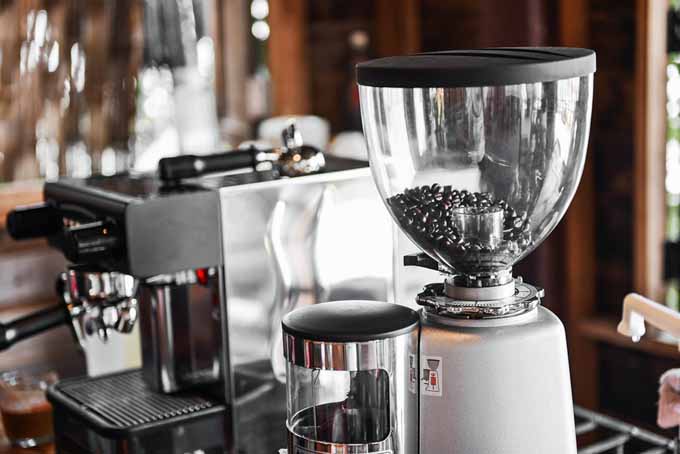
The SINGLE most important factor to any good cup is the freshness of the beans.
Beans start going stale as soon as they are roasted, and are pretty much toast as little as two weeks later – of course, if you buy from the little mermaid shop, they are toast anyway, as they are way over roasted and stale.
The SECOND most important factor in creating the taste in your cup is the grinding process.

Coffee grinders are arguably the most important piece of equipment that you can buy that will exponentially increase your enjoyment of the dark beverage, no matter what brewing techniques you use. This is absolutely critical for good espresso shots.
A quality machine will ensure you get an even extraction of flavors and aromas, every time you grind up a fresh batch of coffee beans.
Bottom Line Up Front: Our Top Picks
 1. The Baratza Encore. This is the little grinder that could. Although not the cheapest model that’s available, it’s far from being the most pricey. If you are looking for a basic model to prepare automatic drip or French press for the average sized home, then this one should be considered. The Encore features European-made 40mm burrs for a consistent grind from start to finish.
1. The Baratza Encore. This is the little grinder that could. Although not the cheapest model that’s available, it’s far from being the most pricey. If you are looking for a basic model to prepare automatic drip or French press for the average sized home, then this one should be considered. The Encore features European-made 40mm burrs for a consistent grind from start to finish.
Read our review below OR Check prices on Amazon!
 2. The Breville BCG820 Smart Grinder Pro. This is another moderately priced model that offers great performance for the money. Available in two (and sometimes three) colors, it’s designed to meet the Spousal Approval Factor (SAF). Faster and easier to adjust than the Encore above, it also features a locking and removable hopper, which means no spilling of beans when swapping out different roasts.
2. The Breville BCG820 Smart Grinder Pro. This is another moderately priced model that offers great performance for the money. Available in two (and sometimes three) colors, it’s designed to meet the Spousal Approval Factor (SAF). Faster and easier to adjust than the Encore above, it also features a locking and removable hopper, which means no spilling of beans when swapping out different roasts.
Read our review below OR Check prices on Amazon!
 3. The Gaggia 8002 MDF. This is one of the granddaddies of the home espresso movement and is still a reasonably priced alternative. Made in Italy, this Gaggia is somewhat hindered for espresso use by its lack of adjustability, but its 39 settings are still more than enough to brew a nice batch of French press or drip. The dosing mechanism and the molded-in portafilter holder (for espresso machine use) can be irritating. Although inexpensive, we’d look at either the Baratza Encore or the Breville in this price range for better usability, or the Rancilio Rocky listed below for durability.
3. The Gaggia 8002 MDF. This is one of the granddaddies of the home espresso movement and is still a reasonably priced alternative. Made in Italy, this Gaggia is somewhat hindered for espresso use by its lack of adjustability, but its 39 settings are still more than enough to brew a nice batch of French press or drip. The dosing mechanism and the molded-in portafilter holder (for espresso machine use) can be irritating. Although inexpensive, we’d look at either the Baratza Encore or the Breville in this price range for better usability, or the Rancilio Rocky listed below for durability.
Read our review below OR Check prices on Amazon!
4. The Rancilio Rocky. The “Tank.” This older, made in Italy model still packs a mean punch, thanks to its overly robust construction. A big, beefy commercial-style motor powers a belt, meaning it produces little noise and the components will last forever. It doesn’t pack as many grind settings or grinding burrs that are as advanced as some of its newer cousins (and has fallen out of favor among espresso enthusiasts), but for the average person seeking a good cup of joe via a press pot, drip, or pour over, this model is a viable contender. It’s what we use in the office, due to its reliability.
Read our review below OR Check prices at 1st in Coffee!
5. The Baratza Preciso. This model is very popular among budget-minded home espresso enthusiasts due to its basic 40 settings, plus an additional 11 micro-adjustments that can be applied to each level. Getting a very accurate grind is hugely important when pulling espresso shots, and the Preciso is among the least expensive models that allows for this level of adjustability. This machine is stronger and better built than its smaller Encore sibling, but packs the same 40mm European-made burr set.
Read our review below OR Check prices on Amazon!
 6. The Baratza Sette 270W. The most innovative design of the past 20 years! A true prosumer-level machine that automatically grinds based on weight. With a very simple burr arrangement that allows grinds to go straight into a portafilter or another container, the tedious job of cleaning every nook and cranny to remove stale coffee residue is a thing of the past. If you are looking for a top-end model at a mid-tier price, the Sette 270W would be hard to beat. We expect this newish grinder to become the darling of home espresso buffs and those really into other forms of brewing.
6. The Baratza Sette 270W. The most innovative design of the past 20 years! A true prosumer-level machine that automatically grinds based on weight. With a very simple burr arrangement that allows grinds to go straight into a portafilter or another container, the tedious job of cleaning every nook and cranny to remove stale coffee residue is a thing of the past. If you are looking for a top-end model at a mid-tier price, the Sette 270W would be hard to beat. We expect this newish grinder to become the darling of home espresso buffs and those really into other forms of brewing.
Read our review below OR Check prices on Amazon!

7. Mazzer Mini Electric. This Mazzer model is one of the most popular among the home espresso crowd, due to its electronic dosing control mechanism that allows for equal measurements when pulling shots. Espresso is very temperamental and each factor involved can vary the taste. The elimination or control of each of these variables is the never-ending quest of a home (and commercial) barista. The 64mm burrs also allow for light, fluffy, consistent grinds, another important variable in dialing in espresso. This made in Italy machine is commercial level in construction but packed into a smaller footprint than most other models.
Read our review below OR Check prices at 1st in Coffee!
8. The Baratza Forte AP. This is one of the better designed models, suitable for all home coffee making chores. From French press to the most finicky of espresso machines (and drinkers), the Baratza Forte AP can deliver. Large 54mm burrs deliver a consistent and fluffy grind, and the aluminum chassis is a step beyond the budget-minded machines normally offered by Baratza. But what truly separates this model from the others is its ability to offer both time-based and weight-based grinding, allowing you to dose just the right amount – critical in espresso and important for those involved in serious pour over brewing. Adjustments are super easy, thanks to the sliding levers.
Read our review below OR Check prices at 1st in Coffee!
 9. The Mahlkonig K30 Vario Single. This is a serious machine designed for serious espresso production. Designed for professional use in cafes and coffee shops, the K30 Vario has also found a home among home espresso enthusiasts (some call us nuts). A large 65mm burr set ensures fluffy grinds and the direct drive motor ensures decades of use. Adjustments and dosing are 100% electronically controlled, allowing accurate shots to be pulled every single time.
9. The Mahlkonig K30 Vario Single. This is a serious machine designed for serious espresso production. Designed for professional use in cafes and coffee shops, the K30 Vario has also found a home among home espresso enthusiasts (some call us nuts). A large 65mm burr set ensures fluffy grinds and the direct drive motor ensures decades of use. Adjustments and dosing are 100% electronically controlled, allowing accurate shots to be pulled every single time.
Read our review below OR Check prices on Amazon!
In this guide, we’ll also cover the following:
- Burrs vs. Blades
- Conical vs. Flat Burrs
- Steel vs. Ceramic Burrs
- Doser vs. Doserless vs. Bins
- Electronic Dosing and Grinding on Demand
- Motor and Gearbox/Transmission Designs
- Other Important Factors You Should Consider
- Nine Models That We Consider to Be Among the Best Available
A Tale of Blades and Burrs
There are two basic types available: blade and burr grinders. Blade models are generally sold in department stores or Bed Bath & Beyond and the like.
Although less expensive, blade-equipped units are not fit to process coffee, and here’s why:
They use a spinning blade to slice up the beans in the best of circumstances, and usually crush them in most situations, leaving the grinds in a ragged mess comprised of variously sized chunks.
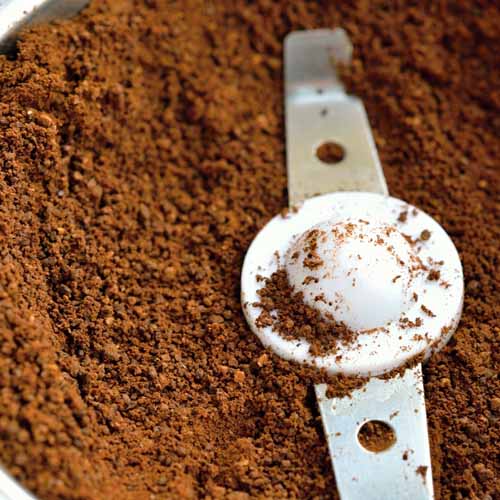
Cheap blade grinders like what you’ll find in most department stores do not properly flake when they process the beans – blade-equipped units merely break the beans apart into irregular chunks that do not allow for a good extraction.
They key to good coffee is consistency: in the grind size, brewing temperatures, tamping techniques (for espresso), and myriad other variables. Learn more about why blade grinders suck here.
So what do you need to make a top quality brew, and how much will it cost?
Here’s the deal:
You should expect to pay, at a minimum, around $130 to get an electric-powered burr grinder of reasonable quality.
Let me say that again:
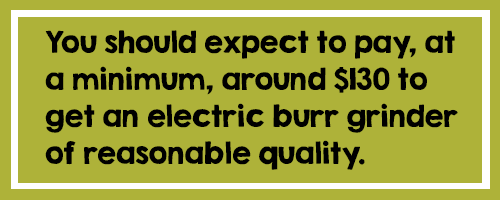
Some folks get by for a while with a less costly hand grinder, and a select few of these models (mostly Harios) do a fair job.
But trust me when I say this:
You will get tired of hand grinding.
You really need a burr-equipped model for optimal (or even passable) results.
These devices use a series of abrasive disks, cones, or balls called burrs to evenly flake or shave the beans rather than tearing, crushing, and compressing them like the blade versions do.
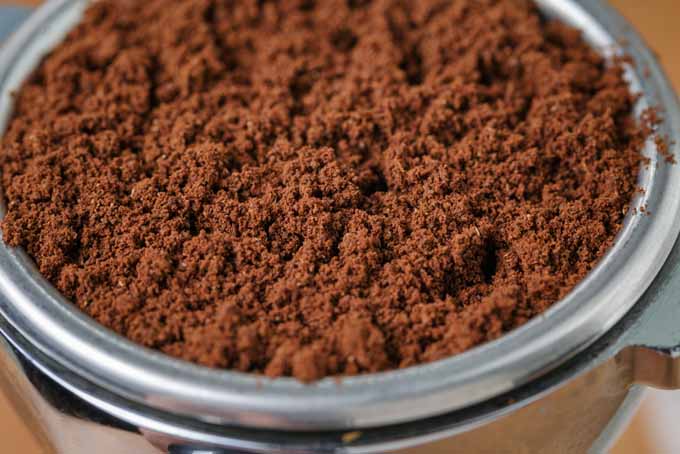
This is THE kind of coffee grinder that you need to buy – no question about it. Anything else is a waste of money, unless you are looking for a spice grinder.
You may have heard that these are expensive. Well, what would you say if I told you that you could find a decent quality burr model for well less than $100? We’ll get to that a little later.
Conical vs. Flat Burrs
There are two primary subgroups of burr-equipped models. The first of these has conical or cone-shaped burrs.
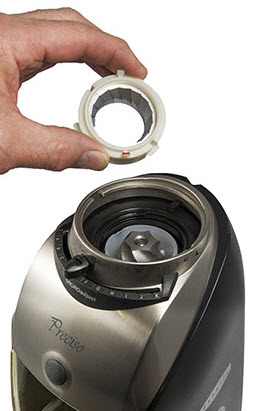
Conical burrs (as seen in the picture in the upper left) are found on a range of levels of models from the bargain or best-bang-for-the-buck class – with cheaper motors that use gear reduction – to the much more expensive direct drive units. (Don’t understand those terms? Don’t worry, we’ll get to them in a moment.)
Due to their special design, the conical style has a larger surface area than the flat variety for any given diameter, and thus these are able to quickly shed heat.
The second type is a flat burr (shown at the lower left), which uses a flat disk with a series of teeth carved into it that rides against a grinding stone or plate. They are generally found in mid-range to higher priced machines.
These are usually larger in diameter than their conical counterparts, and thus are able to shed heat equally well by making their surface area bigger, through a brute size increase.
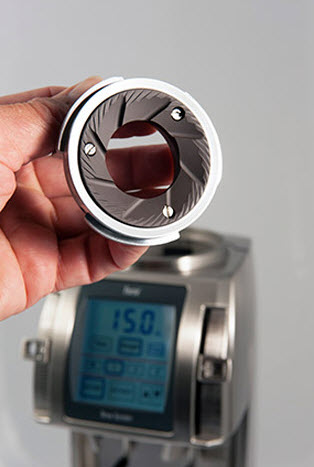
Which is better? The debate rages on across various internet forums. Some claim that the conical burr-equipped models are “easier” to dial in, and produce fluffier grounds for use in espresso machines.
Others claim that there is a distinct difference in the taste, favoring one or the other, with the conical burrs offering a brighter taste with enhanced citrus and “fruity” qualities, while flat burrs tend to enhance sweetness alongside cocoa and caramel tastes.
I believe the rest of the qualities of the machine – in particular, the size of the burr (bigger is better) and the tolerances that went into its manufacturing – make more of a difference than its shape.
Size and Material of Burrs: Steel vs. Ceramic
Burrs are generally made of either high-quality stainless steel or ceramic. Budget, high end, and commercial models all have one or the other, and some offer both. Neither one is better, but they do feature a few different qualities.
Steel Burrs – Advantages
- Stainless steel is generally cheaper to manufacture, and thus is cheaper to replace.
- Much more forgiving if a rock or another foreign object makes its way into the hopper. Although it will do some damage, this will not generally render the machine unusable. Many cafes need this peace of mind so they know they will not be forced to shut down if and when a rock gets into their coffee supply.
- Many high-end coffee shops and advanced coffee hobbyists will use nothing but steel burrs in the production of pour over, automatic drip, siphon, French press, and other non-espresso coffee drinks. Some manufacturers, such as Baratza, that feature ceramic flat burrs in their espresso and “do it all” burr sets, produce optional steel burrs to cater specifically to this market.
Steel Burrs – Disadvantages
- The lifespan is about half the time per pound of coffee as the ceramics, but most can be replaced.
Ceramic Burrs – Advantages
- Last twice as long as steel burrs before requiring replacement. Baratza rates theirs for 750 pounds of coffee, but reports indicate that they may be good for up to 2500 pounds.
- Great for producing the texture needed for espresso.
Ceramic Burrs – Disadvantages
- May shatter if they hit a rock or another foreign object, putting the machine completely out of commission until replaced.
- More expensive to manufacture.
Once again, in my opinion, burr material has little to do with the final output of the grind. It’s all in the profile, and the way the product was designed – i.e. Baratza’s optional steel flat burrs for the Vario and Forte have a profile designed exclusively for French press and pour over brewing methods.

Their ability to remain sharp and to survive any impact is the key takeaway when examining burr construction.
Grinders featuring ceramic burrs include the Baratza Forte, Baratza Vario, Baratza Vario-W, Baratza Preciso, Baratza Virtuoso, and Baratza Encore.
Stepped vs. Stepless
All coffee grinders adjust the grind size by moving the burrs closer or further away from the grinding plate. There are two different designs that accomplish this, and these are referred to as stepped and stepless.
Stepped designs, normally found on budget machines, are adjusted by using a lever or knob to set it to various factory-determined grind sizes. The downside to this is that they don’t offer infinite adjustments – in other words, you are locked in to a certain number of “steps.”
On cheaper models this may be as few as 10, and on more expensive models as many as 40 primary steps. This is not a huge deal if brewing for French press, pour over, or automatic drip, as these methods do not require exact grind sizes to create excellent coffee.
This does matter a great deal for espresso brewing, as any slight change in particle size can greatly influence the flavor.
However, in the last few years, Baratza has introduced several models featuring micro-adjustments.
Basically, there are two controls – one to control large steps and the other to control the micro-steps, effectively giving the applicable models the same range of adjustments as the stepless varieties.
Baratza Preciso – Conical Burr Coffee Grinder available on Amazon
The Baratza Preciso features a control ring that controls its 40 macro steps, and an adjustment lever that controls 11 additional micro steps for a total range of 440 steps.
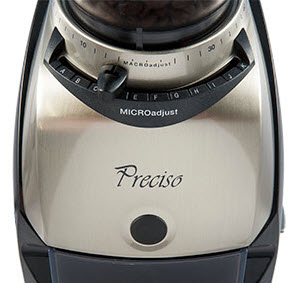
The Baratza Vario and Vario-W models feature two control levers that adjust for 10 macro and 23 micro steps (230 settings total), and the Forte model includes an additional 6 micro steps (for a total of 260 settings).
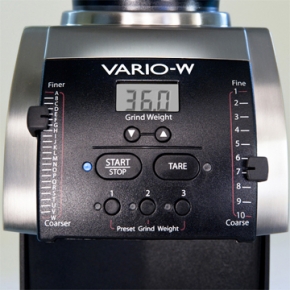
There are several upsides to stepped coffee grinders. Most are easily switchable for different types of brewing methods, and the barista can easily switch from rough grinding for French roast to fine grinding for espresso.
Moreover, stepped models are also easily repeatable. This means they can quickly and easily be returned to various settings.
Other units that are stepped include the Rancilio Rocky Doserless, Rocky with Doser, and the MACAP M4 Doserless grinders.
Stepless coffee grinders, however, may be adjusted to an infinite range between their grind points.
Normally found on units designed for espresso brewing, these machines are able to dial in that espresso grind to the exact specifications determined by the barista.
As very slight variations in grind can have a huge impact on taste, this feature is important at professional coffee bars, and to many home espresso enthusiasts.
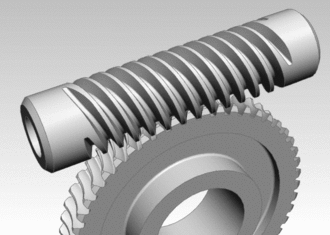
These units operate either by a worm gear mechanism for fine adjustments, such as almost all of the MACAP models, or through resistive collars that create enough friction to allow the settings to remain stable during operation, but that are loose enough that they can be moved manually through the adjustment range – Mazzer and Compak use such a system.
Stepless units can be set up to grind for French press, pour over, and drip brewing methods. But since the available range adjustments are so fine, they are best suited to the espresso applications for which they were designed – for this they positively shine.
Doser vs. Doserless vs. Bins
Coffee grinders use three different methods to collect coffee – dosers, doserless, and bins. Some even include a combination of these. I’m going to give you the pros and cons of each type, but remember: these are generalities. The better models may overcome some or all of the negatives described through better design and construction.
Moreover, electronic dosing controls also have a large influence on machine dosing performance, and these will be covered in the next section.
Doserless
The doserless varieties are designed to dispense ground coffee directly into an espresso machine portafilter basket (what is this?) or into the basket or filter of a drip coffee maker, French press, or pour over brewing device.
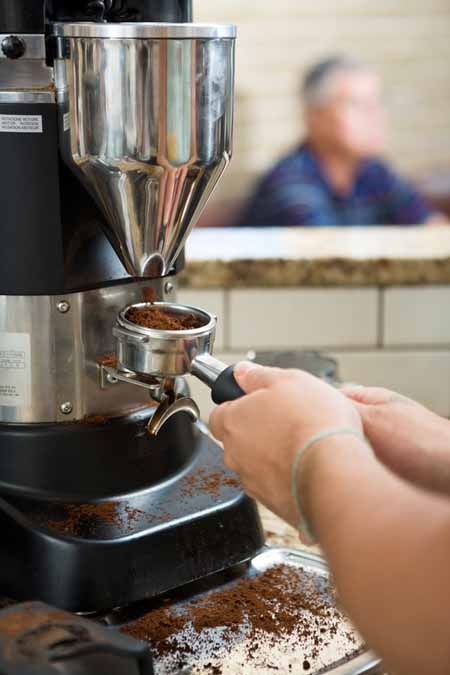
Doserless Pros
- Less old grinds that could go stale and affect future brews are typically left behind in the machine.
Doserless Cons
- They are sometimes based on existing doser designs and the burrs still trap grinds against the finger guard, reducing any advantage in this area (some users remove the finger guards to mitigate this, but this is NOT recommended).
- They often “clump” more than doser varieties.
- They often spray more grinds onto the counter.
- The user usually has to stand in place, holding the portafilter or other container while it grinds.
Dosers
The primary competing design is the doser type. This engineering has existed since at least the 1930s, and is still effective today. These units feature a bin that coffee falls into, and the user must “twang” a lever to release the appropriate amount of coffee grinds.

In this regard, you get what you pay for, with the better doser designs being found on the more expensive machines.
Doser Pros
- Usually less clumping than doserless varieties (but this depends on design).
- Less spillage of coffee grinds than most doserless varieties.
Doser Cons
- May trap more grinds and require more effort to clean out after every use.
- Dosers may not be all that accurate in actually dosing coffee – especially cheaper models.
Grinders with Bins
Baratza is one of the few manufacturers whose products have an internal bin. These operate similarly to dosers, except the coffee grinds fall into the bin, and there is no mechanism for dosing the grinds built into the container.
These are primarily found on home models, and are suitable for French press and automatic drip or manual pour over brewing.

The Capresso 565.05 Infinity Conical Burr Grinder is a great example of a bin-style model. Available on Amazon.
Most of the Baratzas (with the exception of the Vario-W) along with offerings from Breville and others feature portaholder devices that attach in place of the bin, allowing the user to dose directly into a portafilter. Click here to read more about Baratza grinders.
Electronic Dosing and Grinding on Demand
Useful for espresso brewing, some models feature “grind on demand” technology, in which the user selects the size of a shot he or she wants to brew (i.e. single, double, etc.) and the machine grinds just enough coffee to fill the portafilter to the correct amount, based on either weight or time.
Baratza Forte AP (All-Purpose) – Flat Ceramic Burr Coffee Grinder
For example, the Mahlkonig K30 Vario Single and Twin models feature digitally programmed grinding profiles to include timed grinding, grind coarseness, and exact proportioning.
According to the settings, the portafilter is filled automatically as soon as it is inserted.
The MACAP M7 Digitial and the Compak Touch series including the K3 Touch, K8 Fresh, and K10 Fresh all feature similar technology, while the Mazzer Electronic/Electric series utilizes electronic dosing based on time.
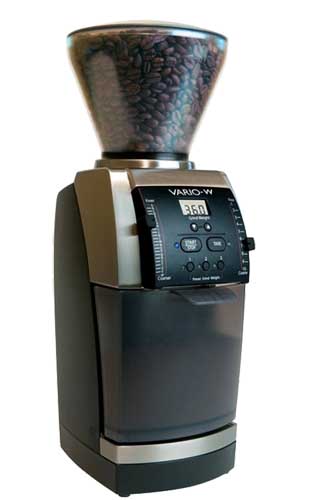
Baratza Vario-W 986 Flat Ceramic Burr Coffee Grinder available on Amazon
We’d be remiss if we didn’t mention the two Baratzas that dispense via weight, based on a built-in scale – these include the Forte and the Vario-W, with the Forte being able to alternatively dispense via time as well. Both of these units are highly recommended and have the ability to adjust the size of your grounds with the flick of a few levers.
The Baratza Esatto Scale Attachment is also available separately, and allows for weight-based dispensing for Baratza’s conical burr models.
Motor and Gearbox/Transmission Considerations
There are three basic motor and gearbox designs that one needs to consider before purchasing a coffee grinder: high speed, high speed with gear reduction, and low speed direct drive.
High Speed
High speed grinders are generally the cheapest of the bunch, both in terms of monetary outlay and in construction. Found on all blade-based machines and the lowest end burr-based models, this category is driven by a cheap high-speed electric motor.
DeLonghi Stainless Steel Burr Coffee Grinder available from Wayfair
Advantages
- This makes it cheaper.
Disadvantages
- High speed units have a tendency to heat up quickly, so it is better to grind coffee beans using short bursts of power. However, this also increases the amount of “stop/start” cycles that the machine has to perform. And this will create more wear and tear on the machine’s parts – ultimately leading to the premature death of the unit.
- These are for light use only, and it is advisable to avoid this type if you want a product that will last more than a couple of years.
An example of this type is the DeLonghi offering shown above.
High Speed with Gear Reduction
These models, equipped with high-speed motors with gear reduction, are usually a much better product than the straight high-speed variety. They still have high-speed motors, but most of them are DC powered (instead of AC), leading to much longer lives.
These feature a gearbox that utilizes the speed of the DC motor, coupled with gear reduction to slow the speed of the burrs while increasing torque.
In addition, this type of machine is generally quieter, has less static buildup in the bins or dosers, and the beans are exposed to less heat. The Gaggia MDF and Baratza Preciso, Baratza Virtuoso, and Baratza Encore models feature gear reduction technology.
Direct Drive
Direct drive models make up the remainder of the available offerings, and are generally found in “prosumer,” professional, and industrial machines. These feature heavy duty, low speed, high torque motors that drive the grinder either with a belt, or attached directly to the burrs through a driveline.
The Baratza Vario 886 – Flat Ceramic Coffee Grinder is a great example of a direct drive model
They turn the burrs through sheer power.
These are the quietest of all models, very durable, and high in quality. These units transfer almost no heat to the coffee, and minimize the chances of static occurring within the grinds.
All of the Mazzers, Compaks, MACAPs, and the Baratza Forte are direct drive. “Prosumer” versions include the Rancilio Rocky Grinders with dosers or without dosers, and the Baratza Vario and Vario-W models.
Other Important Factors You Should Consider
Storage Capacity and Physical Size
It is important to know how often you are going to use your coffee grinder, as most have differently sized bean capacities in the hopper. For example, a busy café would be best suited to buying a larger machine that has the capacity to hold more beans.
Some models feature optional small or large hoppers or hopper extensions, so that one may adjust the amount of coffee it can hold.
Conversely, the larger the hopper, the harder it is to fit under cabinets, and the more room it may take up on the counter – important considerations for home kitchens, but not as much of an issue for a coffee bar.
Are You Grinding for Espresso, Coffee, or Both?
If you are grinding exclusively for espresso, then purchasing a dedicated espresso grinder is recommended. The particles that it will produce are very consistent, and a barista can dial them in to the exact grind needed for the type of beans, bean roast level, and even for temperature and humidity.
An adjustable coffee model works well if you are grinding for a chunky French press, medium drip, powdery Turkish, or even espresso.
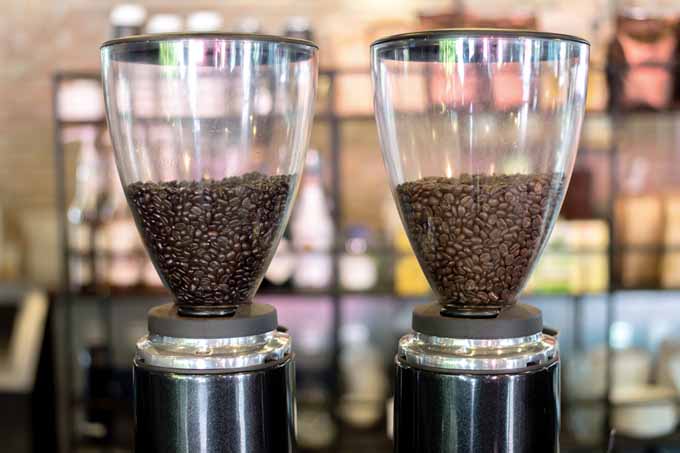
The only downside to these multipurpose machines is that you generally can’t maintain the same consistency as you could with a dedicated espresso grinder, although most of the Baratza models have narrowed this gap considerably in the last several years.
With these you generally get what you pay for, with the more expensive models having better and longer lasting burrs, better consistency, and more adjustments to the grind coarseness.
The various size settings available on the machine and the consistency of the coffee grinds contributes to about 50-60% of the taste, and should be tailored to the brewing method, bean variety and oil levels, roast level, and other variables.
9 of the Best Coffee Grinders on the Market Now: Our Reviews
Okay, the fundamentals have been discussed. Let’s consider the top coffee grinders for the home that are available in the marketplace today, that will give you the best bang for your hard-earned money.
These are quality products that will last you much longer than those found at most big box stores.
These are roughly arranged with the entry level level machines that most people would happy to own at the top, through to examples that would be suitable for serious home espresso enthusiasts towards the end of the list.
1. Most Cost Effective: The Baratza Encore
The Baratza Encore should fill the needs of most casual coffee drinkers, with the exception of those that often prepare large pots of automatic drip.
It doesn’t grind quite fine enough for some espresso machines. But for what it does offer, it’s a heck of a bargain.

Baratza Encore Conical Burr Coffee Grinder
The Baratza Encore is a great entry-level conical burr grinder if you want to grind your own a few times a week, and get fairly fluffy coffee grounds as a result.
We wouldn’t by any means recommend that this product be used for any sort of commercial application, as it is not that robust, and grind times are long (averaging about 90 seconds to get enough coffee to fill a 12-cup pot).
And it does not have enough settings to satisfy diehard espresso fans who need precise control.
But it works very well for those interested in brewing via smaller automatic drip pots, French presses, and the like. At its price point, this is one of the best coffee grinders you can buy for the money.
Read our in-depth review or see it on Amazon now.
2. A Great All-Rounder: The Breville BCG820BSSXL Smart Grinder Pro
This is another decent quality product with a mid-range price. Breville is known for their various kitchen appliances and these are still being manufactured with some level of care (unlike many brands who have licensed their name to lower quality manufacturers).
This model improves on Breville’s older Smart Grinder (the non-pro model) and packs in a lot of features for the price. It is available in two or three different colors – brushed stainless steel and sesame black are the two that are normally available, although there is a cranberry red version that is available intermittently.

Breville BCG820BSSXL in Brushed Stainless Steel
The device now sports 60 grind settings instead of the 25 found on the non-pro model. Moreover, it features an additional 10 micro-settings, which allow you to dial in for those finicky espresso shots that require some trial and error before you get it just right.
Unlike many other budget machines, users report no static buildup in the grounds bin. Static can be a huge issue in various other models, as bean particles cling to the side of the bin where they age, go stale, and then fall off into the next batch.
When this happens, it can lead to producing cups with an off-flavor – and this is definitely not what you want. Breville has cracked the code with the static issue.
Another place that stale grinds can hide is in the internal workings of the grinder. Unlike some models, this unit is super easy to clean, and disassembly (at least to the point where you need to be able to clean it) is a snap.
Other improvements include the dosing function, which has been improved and is now based on time (whereas on the previous model it was based on “brew strength”) and is repeatable to 0.2 seconds.
If you are grinding the same kind of beans, you can use this feature to get repeatable results, which means less waste for any form of brewing. And it also allows you to grind into an espresso machine’s portafilter (though for best results, you’ll still want to weigh it).
Similar to Baratza’s optional Shut Off Hopper, this “smart” model features a hopper that can be locked and removed without spilling the beans.
This is incredibly useful should you want to change the variety that you’re grinding. With the Baratza, you can also easily order extra hoppers, should you want to keep a few ready to go. Ordering parts through a huge multinational conglomerate, on the other hand? Not so easy.

Breville BCG820BKSXL in Sesame Black
This point brings me to support, service, and warranties. Getting in touch with a company as large as Breville can be a challenge. Emails can go unanswered, and getting a response is often a lot more difficult than getting assistance through a smaller company such as Baratza, which offers stellar support and warranty service.
Bottom line: it’s a very good machine that is suitable for all forms of brewing (including entry level espresso).
But just hope you don’t have problems that require reaching out for support.
Personally, I’d invest in a Baratza Preciso (reviewed below). For just a little more money, it has many more settings available and is backed by Baratza’s awesome support, should you ever need a replacement part (and I’m talking years down the road).
That being said, these Breville units are of decent quality, and are some of the prettiest of the bunch – which may help win the Spousal Approval Factor. That is definitely something to consider if you happen to have a She or He Who Must Be Obeyed in the house!
3. Still Good But Starting to Show Some Age: The Gaggia 8002 MDF
This is yet another decent product that’s priced in the mid-range. This is an older design that uses the same burr set as the Rancilio Rocky Grinders, and it is also made in Italy (more than likely made for Gaggia by Rancilio).
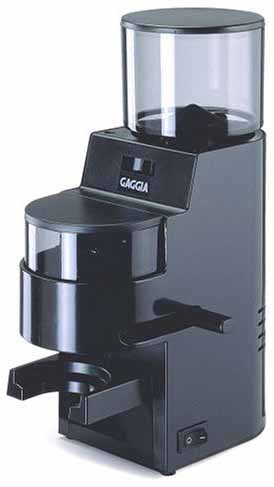
Gaggia 8002 MDF Burr Grinder with Doser, Black
It produces good quality grounds for French press and drip brewed coffee. Like the Rocky models (discussed below), this model is somewhat hindered by its 39 settings, which make it difficult to dial in an espresso shot. But of course, this is a non-issue if you’re not brewing espresso.
However, it does present some issues that affect its usability for all forms of coffee extraction.
The foremost of these problem areas is the cheap doser. This mechanism is really only suitable for filling up a portafilter, and using it for other forms of brewing can be a chore – not impossible, just irritating.
Even more concerning is the flimsy lever attached to the doser – users report that this piece often breaks, and many of them resort to ordering parts from Europe (which is not too bad if you happen to live in Europe, but not so great if you are based elsewhere).
This grinder is past its prime (in my opinion), a leftover from the time when the Gaggia Baby/Classic and the Rancilio Silvia Espresso Machines were the pinnacle of home espresso making, when the Gaggia MDF, the Rancilio Rocky, or investing in a commercial model were your only real options – but not so much these days.
I’d suggest that if you want similar features, a more convenient dosing method, and much more robust construction, then pony up some additional cash and take a serious look at the Rancilio Rocky Doserless that is reviewed below.
The Gaggia is not a bad model at its price point. I just think you can spend your dollars more wisely and get a better machine at the same price, or add a few bucks for a much more robust and capable unit.
But don’t take my word for it, read all of the customer reviews on Amazon and make your own educated decision.
4. Best Grinder Build Quality and Quiet Operation: The Rancilio Rocky – Doserless Version
Once the king of home coffee grinding, the Italian-made Rancilio Rocky still remains relevant in today’s world of either too much tech, or too many inferior products.
Thanks to its heavy-duty motor – the same one that is installed in the brand’s Commercial MD40 – and belt drive to the burrs, this top-rated grinder is at least 50 percent less noisy than others in the same price class that are driven by tiny motors and gear reduction.
Rancilio HSD-ROC-SD Rocky Doserless Coffee Grinder
Also, its heavy duty all-aluminum construction has given it the nickname “The Tank” among home coffee aficionados.
While newer models in the same price bracket offer more settings, this will be the last model you’ll ever need to purchase for non-espresso applications – the construction quality is that robust.
In fact, I use one personally for my everyday morning coffee.
Read our full review or check it out at 1st in Coffee now.
5. Best for Budding Espresso Adventurers: The Baratza Preciso
There is a reason that the Baratza Preciso is often recommended as the best bang-for-the-buck grinder for folks with newly acquired espresso machines. The versatility you get at this price point is second to none.
Baratza Preciso – Conical Burr Coffee Grinder
The Preciso combines the 40 steps found on the Baratza Virtuoso with an additional 11 micro-steps in between each primary setting, allowing you to dial in your espresso shots just the way you need them to extract flavorful pulls.
Combined with its impressive 40mm European-made conical burr set, this is one budget model that works for drip and other brewing processes, and lets you play barista and produce consistent espresso shots with the big boys and girls.
With a more robust build quality and much faster operating times over the brand’s entry level Encore, you may want to step up and future-proof yourself with this one.
An additional attachment, the Esatto Scale, also allows you to grind based on weight instead of relying on the built-in timer mechanism.
Read our in depth review or see this fine machine on Amazon now.
6. For Those Starting to Get Serious About Espresso: The Baratza Sette 270W
The Baratza Sette 270W is like no coffee grinder that has come before it.
The machine was designed by Mahlkonig (a top European-based coffee grinder manufacturer) to be one of the simplest but most precise dosing models that is available today.
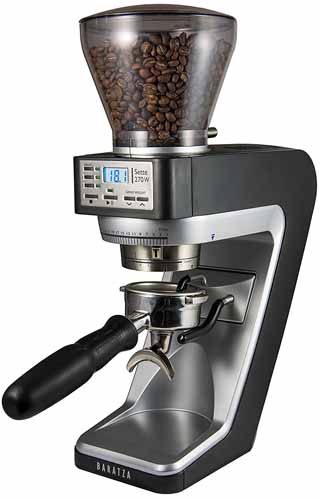
Baratza Sette 270W – Conical Burr Coffee & Espresso Grinder available on Amazon
Here’s the deal:
Unlike the vast majority of other models, the Sette 270W model measures by weight, not by time – meaning that you can grind directly into an espresso machine’s portafilter and pull shots without clumsy weighing techniques or guesswork. A highly accurate Acaia scale is built in!
What’s more, thanks to a new design that features a fixed inner burr and and a rotating outer burr, the machine passes grinds straight through into the portafilter or the bin without passing through dossers, shoots, or other apparatuses, eliminating any worry about stale grinds contaminating your brew.
This direct grind path also prevents clumping.
The portafilter holder is convertible, allowing you to also grind into the included anti-static bin, into your pour over mechanism of choice, or even directly into a small to medium Chemex glass coffee maker.
The adjustment mechanism is a thing of beauty. The top ring allows for a macro adjustment while the lower ring allows the brewmaster to fine tune the grind. This is THE smoothest operating mechanism among all prosumer level coffee grinders.
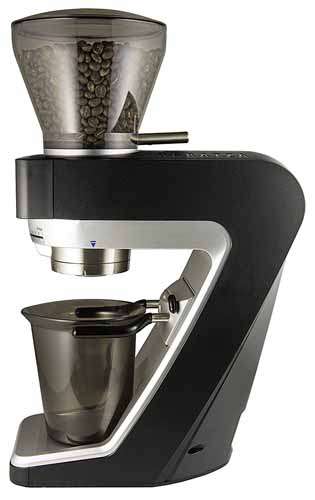
One you have your coarseness adjusted and your weight set, simply hit the go button and let the machine do its thing. There is a small pause right before grinding commences to allow the scale to tare, but then the machine is incredibly fast (but a bit loud).
Bluetooth functionality is built in and various logs can be kept through the Acaia Brewbar App. This could be an important feature for espresso buffs and pour over hipsters looking to dial in their favorite coffee roasts.
Although the machine is assembled in Asia, the burrs (like all of Baratza’s offerings) are manufactured by Mahlkonig in Liechtenstein.
Please note that there is a non-W version that weighs by time and not weight that is a bit cheaper; we’d stick with the 270W.
Without having to mess with weighing the grinds, your home brewing experience is significantly sped up and the lack of orifices to clean means this one is a definite keeper.
The Sette 270W model would be our top choice for anyone NOT looking to spend $1000 or more on dedicated espresso grinder (the 270W rings in for about half of that).
Read more reviews on Amazon now.
7. The De Facto Standard for Home Espresso Brewing: The Mazzer Mini Electric
The Mazzer Mini Electric has become the standard in home espresso grinding, to which all others are compared.
Mazzer is a premier Italian manufacturer with one of the highest quality control processes in the industry, and this brand has won the trust of almost all cafes with their commercial offerings.
Mazzer Mini Electronic Coffee Grinder Type A Doserless
They have been able to pack most of their best features into the Mini Electric, and produce it in a small enough form that it can fit under your kitchen cabinets. It won’t overpower other appliances in the kitchen either.
Featuring 64-millimeter flat stainless steel burrs, this top notch grinder has the capacity to mill your espresso beans to an exacting standard.
The electronic dosing controls allow you to find just the right amount of grounds to perfect your extraction. And unlike models with dosers, it eliminates the worry that grounds may become trapped and go stale inside, affecting the taste of later shots.
It’s available in black, powder coated silver, and polished aluminum in two variations – Type A and Type B. Type A machines provide the electronic dosing buttons on a digital touchpad located on the dosing funnel. On the Type B models, the electronic dosing adjustment controls can be found a bit above the portafilter resting fork.
The only issue with Mazzer is actually acquiring one! Due the Mazzer’s rigorous quality control procedures, dealers must place orders six months in advance, and they can sometimes be out of stock for a couple of months at a time.
8. For Those Who Want One Grinder to Rule Them All: The Baratza Forte AP
The first and best grinder produced by Baratza with an eye to commercial applications, this Forte model improves on the already great features of their Vario and Vario-W models.
This is THE BEST grinder for those who weigh every dose, brew everything from French press to espresso, and want one grinder that excels at almost everything.
Baratza Forte AP (All-Purpose) – Flat Ceramic Burr Coffee Grinder
A larger motor and belt drive power the 54-millimeter flat ceramic burrs, producing some of best quality espresso grounds that are often compared to the output of the famous Mazzer Super Jolly and Super Jolly Electronic, but in a much smaller size.
However, the Forte takes this one step further by offering both time-based and weight-based dosing built into the machine.
A built-in scale gives you the ability weigh each dose, and the machine features the ability to be programmed to remember the dosing weight and correlate it with a time, so that you can configure it to remember exact variations based on different bean types, roast levels, and so on.
Moreover, the Forte features a new “shut off” hopper that allows you to close a valve, trapping the beans in the hopper for easy removal with no mess – the shut off hopper is also available as a separate accessory for other Baratza models.
And the Forte AP is just not for espresso. Sliding levers make adjustments for coarser grinding for automatic drip, pour overs, French press, and vacuum brewing fast and easy.
You merely adjust the sliding control mechanisms to either side of the LCD display, and change your settings by either a serious jump in coarseness with the macro slider, or dial it in with the micro slider.
All-aluminum construction ensures that the Forte AP will remain a trusted part of your coffee brewing arsenal for years to come, and its small footprint ensures that it will fit beautifully into your kitchen.
Read Foodal’s in depth review or find it at 1st in Coffee now.
9. For Those Who Want the Ultimate in Espresso: The Mahlkonig K30 Vario Single
The Mahlkonig K30 Vario is actually designed for commercial establishments, but that doesn’t stop many espresso fans from using it in the home.
Mahlkonig has designed a short hopper specifically to fit the K30 into smaller spaces, and it is available as an option when you order with no additional charge. This can also be bought separately later.
Mahlkonig K30 Vario Espresso Grinder
The Mahlkonig K30 Vario won the Red Dot Design Award in 2005 for innovative features, while perfecting a unique and truly beautiful appearance.
This is not your granddaddy’s grinder.
A 65-millimeter flat burr set and adjustable speed gives you total control in flaking your beans, and programmable dosing allows you to set the parameters to your preferred specifications.
What makes the K30 Vario unique is the “grind on demand” feature. Simply select the size shot you want, stick your portafilter into the very well built holder, and the machine automatically grinds to your desired texture – hands free.
The heavy-duty direct drive commercial motor on this beast ensures that you will have a quiet milling experience, unlike some of the smaller home models that drive tiny screaming motors through a series of gear reductions.
If you are into espresso, you know that the grinder accounts for 50% of the taste, or more (with 40% going to the freshness and quality of the beans, and maybe 10% attributable to the espresso machine).
This is THE top coffee grinder to get if you are serious about home espresso.
Read Foodal’s in depth review or see it on Amazon now.
Weighing the Options
No matter what method of coffee making you use, purchasing a grinder is critical to getting the very best flavors.
Regardless of which style you choose, always buy the best you can reasonably afford. If you’re just getting into home coffee making but you want a quality machine that you can grow into, I wouldn’t hesitate in recommending the Baratza Vario-W.
It won’t be the very best performer in grinding for espresso (for the absolute pinnacle for pulling shots, you really need a very large commercial unit with the largest burrs available), but it’s more than adequate for home use, and it can easily be adjusted for other forms of brewing by flipping a few levers.
Please tell us, in your opinion, which model is best for home use and why.
Also, please feel free to read more guides and explore our top picks in Foodal’s Grinder Section, or check out the entire Coffee Portal where we have many guides and articles available, in order to help you to make informed choices and learn new techniques.
Don’t forget to Pin It!
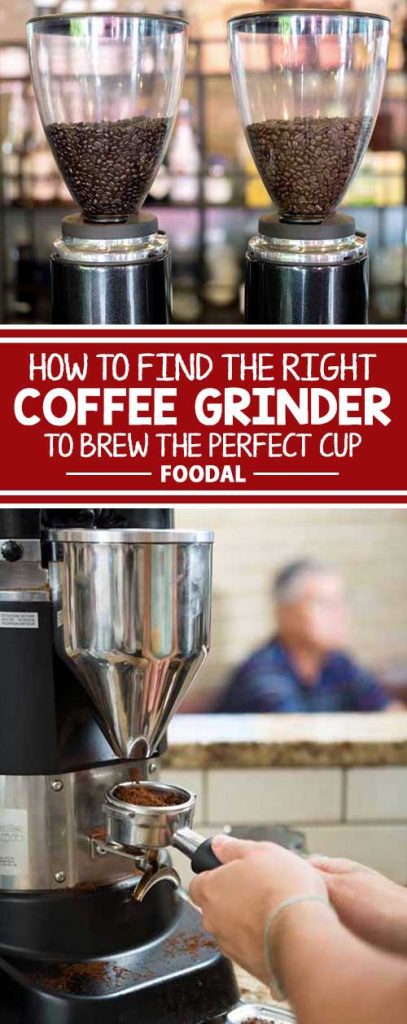
Originally published August 1st, 2015, last updated and revised March 19th, 2017.
About Mike Quinn
Mike Quinn spent 20 years in the US Army and traveled extensively all over the world. As part of his military service, Mike sampled coffee and tea from all virtually every geographic region, from the beans from the plantation of an El Salvadorian Army Colonel to "Chi" in Iraq to Turkish Coffee in the Turkish Embassy in Kabul, Afghanistan. He spent nearly a decade in the Republic of Korea where he was exposed to all forms of traditional teas. Mike formerly owned and operated Cup And Brew, an online espresso and coffee equipment retail operation.



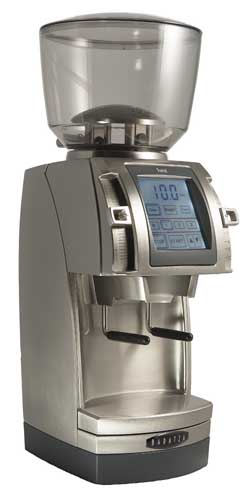
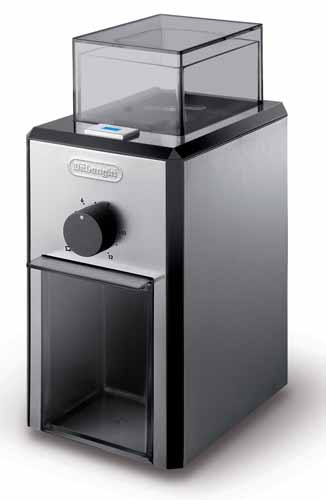
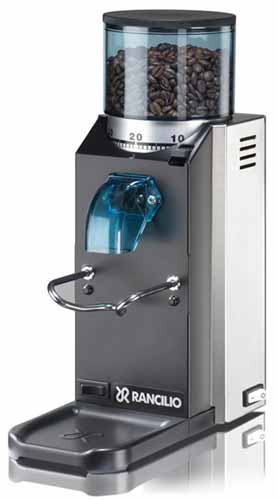
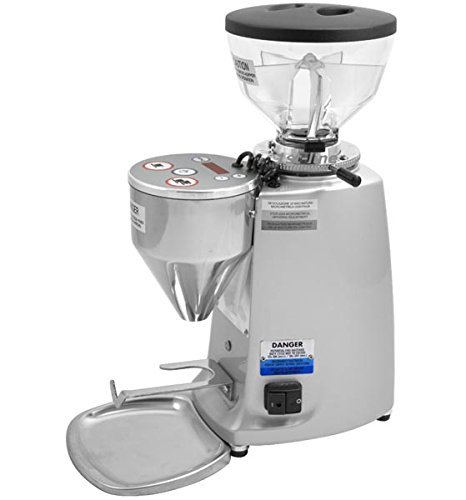
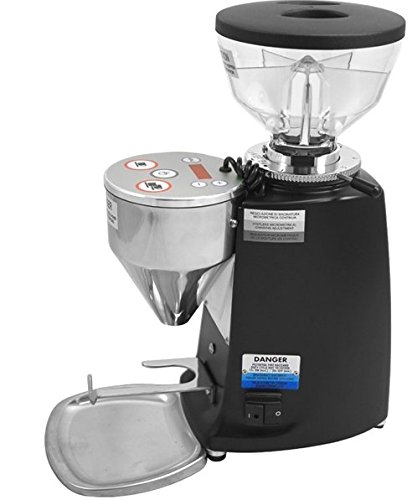
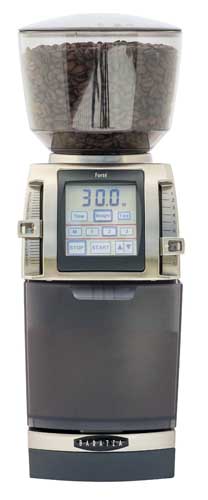
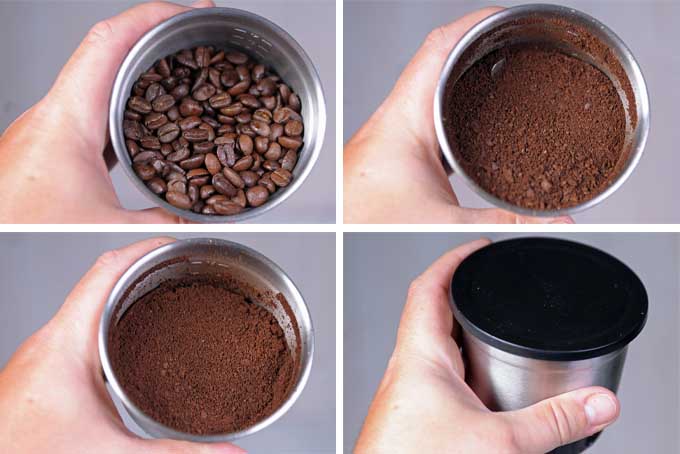

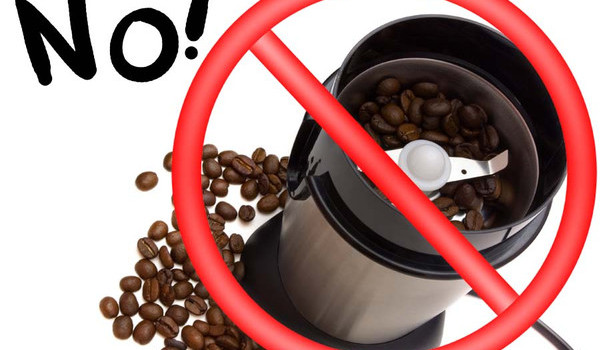
What a great variety of information. My husband has some beans in the kitchen cupboard now that need grinding up. We currently don’t own a grinder because we have a Keurig and the beans were a gift. However, we do still use a regular coffee maker some of the time. Thanks for the information.
Intense information right there…wiping my brow…phew!…page bookmarked for several re-reads, by the time I’m done, the wisdom I gain, will go along way in sheltering me from making careless buying mistakes if and when I decide to purchase one of these 🙂
I have had a problem with the short lifespan of roasted beans before, but I have not used a milling device beyond the blade type that I purchased from Bed, Bath & Beyond. This is quite a lot of new information to process, especially considering that I did not know of the existence of a burr grinder prior to today. Thank you for the insight into the creation of one of my favorite drinks; I appreciate the plethora of relevant tips!
Recently, my family got a Cuisinart coffee maker with a built in grinder (blade sadly). I have noticed that no matter what kind of beans we get, dark roast, light roast, flavored, they all seem to taste weak. I’m not sure if it is the machine or just not the right amount of beans, but I was very glad to have found this article and will be taking it all into consideration when we buy a new one.
Many home coffee makers don’t heat the water to the appropriate level to get good extraction. Ideally you’d like your water to be in the 195-200F range for brewing drip coffee. Use a good thermometer to see what your water temp is right when it drips from the machine.
I bought the Moccamaster from Technivorm about 7 years ago and haven’t had any regrets. One major factor was that at the time it was only one of two coffee makers that heated the water to the correct temperature. I also love the build quality and overall appearance. I highly recommend it. I hope this was helpful. Paul C.
This article is jam packed with useful information I’ve never considered before. Although I love a cup of joe, I don’t do too much of making it myself. I usually get someone else to make it for me whether it be a family member or Starbucks. Now I understand why enthusiasts debate so much about coffee maker parts. Not only is the type of blades taken into consideration but how it’s shaped and what type of material it is made out of.
These also make great gifts so I am definitely bookmarking. My partner will drink a pot day, and his grinder lost its lid so I’m thinking it might be time for a new one. Nothing like the smell of freshly ground java in the morning, that’s for sure. Thank you for all the information!
I’m not a coffee drinker at all, I prefer tea. However, this post will help me find a nice gift for someone who is.
As an self-admitted caffeine addict myself, this is a really great article. I need cup or three every single morning, and suffice to say, it is an important part of my day. I find that the aroma alone is enough to perk me up, and that it truly is the nectar of the gods. But I digress, this is a very well written and well researched article. Maybe I will use this as a basis the next time I am in the market for a coffee grinder. Thank you for your advice, and good luck.
Wow, what a thorough investigation into the different technologies of coffee grinding. This is one of the things that you don’t think their would be much to it but there really is. I use the cheapo-special for processing my beans, but that’s only because I drink a couple of cups for the role reason of bringing me to life in the morning. If I ever plan on going the espresso route though, I have this article bookmarked.
Do you know if the Macap M4 can be used to grind chopped up cinnamon sticks. I have heard of some coffee grinders being used for that purpose, the Rancilio Rocky being one of them, verified by technical support at Rancilio. Thanks.
we tried the DeLonghi KG89, and it had a very short life. Definitely not recommended.
For some reason I cannot scroll your article on my iPad. I also cannot pinch to zoom in / out.
You are somehow locking out touch-navigation. Tried Safari and Chrome; same problem.
I did learn that if I double-tap in the lower right it scrolls down, but this is NOT how tablet viewing is supposed to work.
Hey nice post! Would you recommend a burr grinder for a drip-feed coffee maker?
I only recently found out that having a quality grinder could increase the overall taste of the bean. My wife and I started roasting coffee from home and were wondering what we could do to perfect the taste. The final touch was investing in a new coffee grinder. If you buy one at a super store you’re going to get what you pay for. Great article!